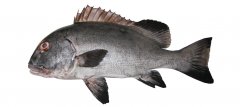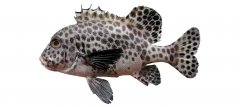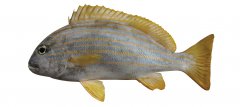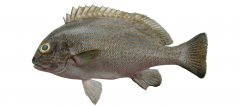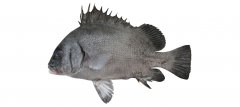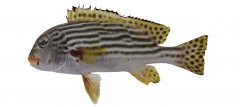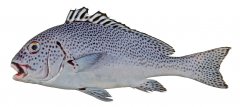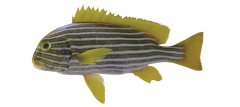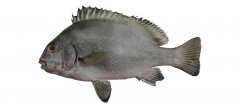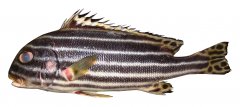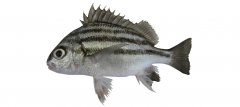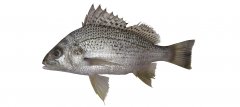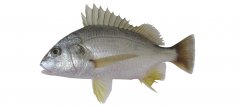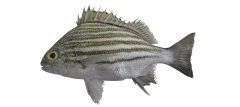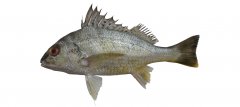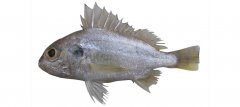-
- Dorsal fin with 9 or 10 spines and 21–26 soft rays; 16–20 scales between lateral line and dorsal-fin origin Diagramma
- Dorsal fin with 11 or more spines and 14–22 soft rays; 10–17 scales between lateral line and dorsal-fin origin Plectorhinchus
-
- A vertical black band about 8 scales wide over nape, terminating about 3 scales below lateral line; about 6 black blotches posterior to the vertical band; spinous part of dorsal fin with a large black blotch Pomadasys maculatus
- Colour not as above 2
-
- Body with 4 distinct black stripes, the lower one behind eye to middle of tail base Pomadasys andamanensis
- Body with 6 brown stripes that bifurcate anteriorly; the bands becoming more numerous with growth Pomadasys furcatus
-
- Body with dark spots or blotches arranged as horizontal rows or vertical interrupted bars; dorsal fins with distinct spots or dark blotches; dorsal-fin rays usually 14 5
- Body without dark spots or blotches, juveniles of P. trifasciatus have 3 darker stripes of which the middle one is broadest; opercle with distinct dark spot; dorsal fins unspotted or with a few vague darker blotches on base only; dorsal-fin rays usually 13 6
-
- Body with pairs of spots or dull blotches arranged into vertically interrupted bars; old specimens may be uniformly coloured with dark blotches or spots on dorsal fins; circumpeduncular scales 20 Pomadasys kaakan
- Body with conspicuous rounded spots, scattered on body or forming lines or rows of spots on back; circumpeduncular scales 21 or 22 Pomadasys argenteus
-
- Second anal-fin spine usually longer than length of snout plus diameter of eye; eye diameter usually less than depth of caudal peduncle; first gill arch with middle gill rakers about 2/3 length of gill lamellae; circumpeduncular scales usually 18 or 19 (rarely 20); lining of abdominal cavity pale Pomadasys argyreus
- Second anal-fin spine about equal to or shorter than length of snout plus diameter of eye; eye diameter about equal to depth of caudal peduncle; first gill arch with middle gill rakers about equal to length of gill lamellae; circumpeduncular scales usually 21 to 23 (rarely 19 or 20); lining of abdominal cavity black Pomadasys trifasciatus
-
- Upper head and body with numerous small dark brown close-set spots, spots on head usually not forming rows; lower 1/4 to 1/3 of caudal fin black; third or fourth dorsal-fin spine longest; pelvic fins reaching to or beyond anus in adults Diagramma melanacrum
- Upper head and body of large juveniles and sub-adults with small yellow to orange close-set spots, adults either with or without spots, if present, spots yellow to orange forming short bars or wavy lines on cheek of juveniles and subadults; lower 1/4 to 1/3 of caudal fin not black but sometimes dusky to black near lower margin in juveniles and subadults; second dorsal-fin spine longest; pelvic fins not reaching anus in adults Diagramma pictum
-
- Anterior half of soft dorsal fin black; caudal-fin lobes, particularly lower, tipped with black; pectoral, pelvic, and anal fins dusky to black; dorsal-fin spines usually 13 (rarely 12); dorsal-fin rays 16–20 Plectorhinchus albovittatus
- Soft dorsal fin uniformly coloured; dorsal-fin spines 12 or 14 (rarely 13) 3
-
- Juveniles with caudal fin pink; dorsal-fin with 14 (very rarely 13) spines and 15–17 (mostly 16) soft rays Plectorhinchus gibbosus
- Juveniles with caudal fin yellow; dorsal fin with 12 spines and 18–20 (rarely 20) soft rays Plectorhinchus unicolor
-
- Body with orange, gold, or rust-coloured spots fading with age; head with narrow, undulating yellow to rust coloured lines; gill rakers on lower limb of first gill arch 16–19 Plectorhinchus flavomaculatus
- Colour not as above; gill rakers on lower limb of first gill arch 22 or more 6
-
- Body with numerous dark brown to black spots much smaller than pupil; pelvic fins dusky with a basal red brown blotch or streaks, not spotted; total gill rakers on first gill arch 33–37; longest dorsal-fin ray about 1/2 length of soft dorsal-fin base or less Plectorhinchus pica
- Body with numerous dark brown spots, subequal to pupil; pelvic fins spotted, darkening with age; total gill rakers on first gill arch 36–43; longest dorsal-fin ray almost equal to length of soft dorsal-fin base in small specimens, more than 1/2 length of soft dorsal-fin base in adults Plectorhinchus chaetodonoides
-
- Juveniles brown with large dark edged white spots on body; gill rakers on lower limb of first gill arch 26 or more Plectorhinchus chaetodonoides
- Colouration not as above; gill rakers on lower limb of first gill arch 25 or less 9
-
- Light areas with or without dark spots; black areas break up into dark spots; white ventrally pectoral fins pale Plectorhinchus pica
- Light areas with darker spots that elongate and change into dark horizontal stripes; pectoral fins black or with black blotches Plectorhinchus vittatus
-
- Upper stripes horizontal on body across nape, interorbital and snout Plectorhinchus vittatus
- Upper stripes horizontal on body but bending downward and converging on snout 12
-
- Juveniles with 3 or 4 white stripes on a dark brown or black body, changing to about 4 dark brown stripes above pectoral-fin base, none below except 2 below eye on head; pelvic fins with anterior half except margin black or dark brown; total gill rakers on first gill arch 19–22, of which 11–15 on lower limb Plectorhinchus lessonii
- Colour not as above; total gill rakers on first gill arch 26 or more, of which 17 or more on lower limb 13
-
- Three narrow light stripes on body fading with age; upper anterior part of soft dorsal fin dark brown to black; tips of caudal-fin lobes blackish Plectorhinchus albovittatus
- Usually more than 4 light stripes on body; pelvic fins without an area of black pigmentation; stripes splitting and increasing with growth 14
-
- Numerous diagonal stripes broken into spots in adults, subadults and juveniles with few, horizontal stripes; upper pectoral-fin base red; caudal fin yellow with black spots and posterior margin; dorsal-fin spines 12 or 13 (usually 13) Plectorhinchus lineatus
- 5–9 horizontal dark edged stripes on sides, juveniles with fewer stripes; stripes flow onto yellow caudal fin in a diagonal manner and fade with growth; fins yellow, unspotted; dorsal-fin spines 12 (rarely 13) Plectorhinchus polytaenia
-
- Pale blue or white horizontal stripes edged with dark brown Plectorhinchus polytaenia
- Stripes not dark edged 16
-
- Pale blue to grey with bright yellow horizontal stripes on head and body; all fins uniform yellow Plectorhinchus chrysotaenia
- Pale blue to grey with bright yellow horizontal stripes on head and spots on body; dorsal fin not uniform yellow Plectorhinchus flavomaculatus
Lethrinidae
Emperors

Lethrinidae differ in having scales absent between eye and mouth (vs. scales present); pores absent on chin (vs. 2 or more pores present) and second anal-fin spine moderate (vs. very strong).
Lutjanidae
Snappers

Lutjanidae differ in having no pores on chin (vs. pores present); canine teeth usually present (vs. teeth conical, no canines) and second anal-fin spine weak (vs. very strong).


